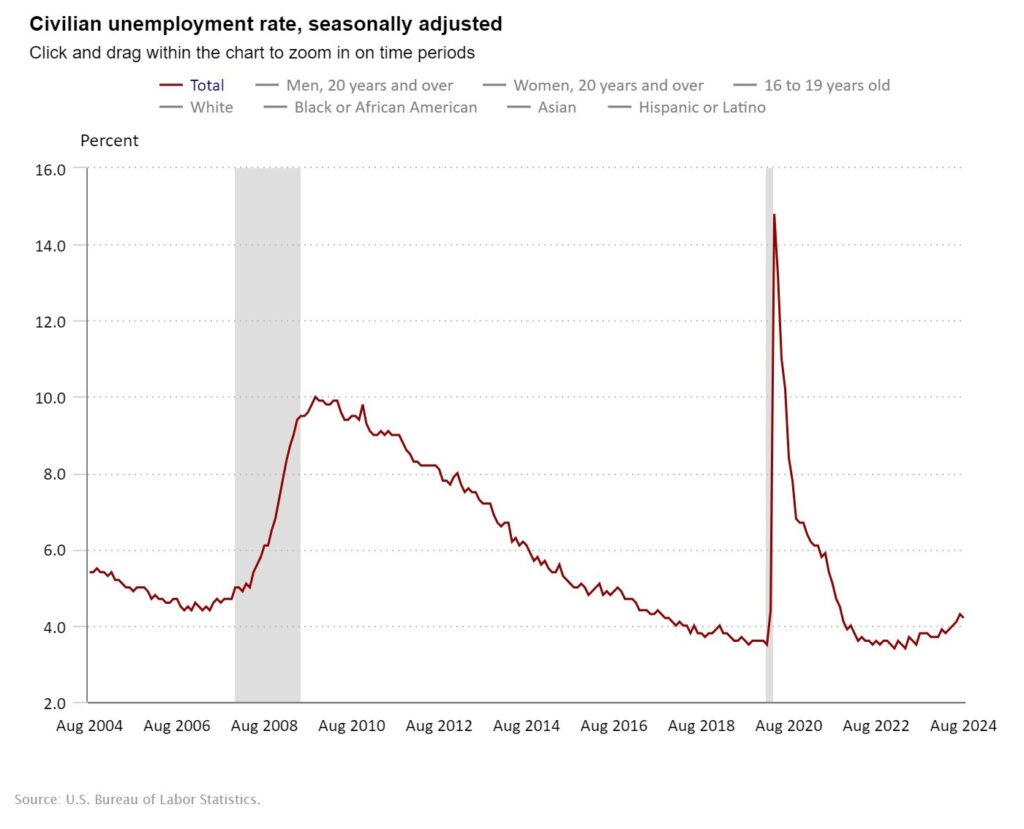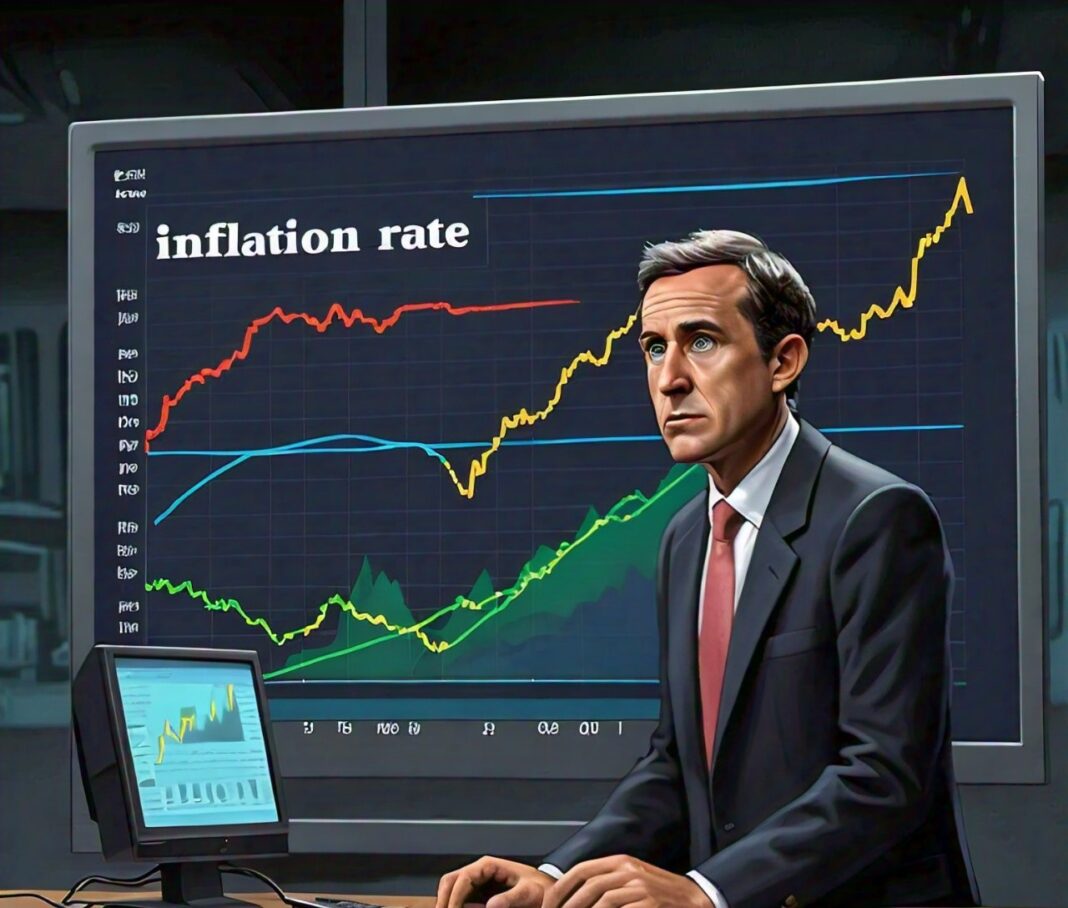Unemployment rates serve as a crucial economic indicator, reflecting the health of a nation’s labor market and overall economy. Defined as the percentage of the labor force that is unemployed and actively seeking employment, these rates provide insights into the availability of jobs and the economic conditions influencing employment opportunities. For policy makers, understanding unemployment rates is imperative for crafting effective economic policies that address labor market challenges and support workforce development.
The importance of analyzing both current and historical unemployment data cannot be overstated. Historical trends reveal patterns that can inform future policy decisions, helping to anticipate potential economic downturns and identify areas needing intervention. Recent fluctuations in unemployment rates have further underscored the need for adaptive strategies, particularly in the wake of significant events such as the COVID-19 pandemic, which dramatically altered employment landscapes across various sectors.
This article aims to delve into the intricate relationship between unemployment rates and government economic policies. By examining historical and current data, we will identify key trends and explore how these trends influence policy formulation. Ultimately, the goal is to equip policy makers with the insights necessary to make informed decisions that promote job creation, economic stability, and equitable growth in the labor market.
Overview of Unemployment Rates
Unemployment rates are a vital metric for assessing economic health and labor market conditions. They quantify the percentage of the labor force that is unemployed and actively seeking work, providing a snapshot of job availability and economic stability. Understanding the intricacies of unemployment rates is critical for policy makers who aim to address economic challenges and promote workforce development.
Types of Unemployment
To fully grasp the implications of unemployment rates, it’s essential to understand the different types of unemployment:
Cyclical Unemployment: This type occurs during economic downturns or recessions when demand for goods and services decreases, leading to layoffs.
Structural Unemployment: This arises from fundamental shifts in the economy, such as technological advancements or changes in consumer preferences, which can render certain skills obsolete.
Frictional Unemployment: Often temporary, this type occurs when individuals are transitioning between jobs or entering the labor force for the first time.
Seasonal Unemployment: This type is related to seasonal work patterns, such as agriculture or tourism, where employment fluctuates throughout the year.

Measurement Methods
Unemployment rates are typically calculated using data from labor force surveys conducted by government agencies. In the United States, the Bureau of Labor Statistics (BLS) plays a key role in gathering and disseminating this data. The unemployment rate is calculated using the formula:

The labor force includes all individuals who are employed or actively seeking employment, excluding those not in the labor market, such as retirees and students. For more in-depth information about labor force statistics, consider visiting the Bureau of Labor Statistics for the latest data and analyses.
Limitations of Unemployment Data
While unemployment rates provide valuable insights, there are limitations to consider:
- Underemployment: Individuals working part-time but desiring full-time work are often not fully captured in traditional unemployment statistics.
- Discouraged Workers: Those who have stopped looking for work due to a lack of job opportunities are not included in the unemployment rate, which can paint an overly optimistic picture of the labor market.
- Regional Disparities: Unemployment rates can vary significantly by region, making national averages less informative for local policy decisions.
Understanding these nuances is crucial for policy makers aiming to address unemployment effectively. By recognizing the different types of unemployment and the limitations of the data, they can develop targeted interventions that cater to the specific needs of the labor market.
Historical Trends in Unemployment Rates
Understanding historical trends in unemployment rates is essential for policy makers to identify patterns, learn from past economic cycles, and make informed decisions that shape future labor market interventions. By examining how unemployment has evolved over time, policy makers can better anticipate potential challenges and opportunities within the economy.
Longitudinal Analysis
Historically, unemployment rates have experienced significant fluctuations influenced by various economic events. For instance, in the United States, the unemployment rate reached a peak of approximately 25% during the Great Depression in the 1930s, highlighting the devastating impact of economic collapse on the labor market. In contrast, during the late 1990s economic boom, unemployment rates fell to historic lows of around 3.8% as the tech industry expanded rapidly.
More recently, the 2008 financial crisis resulted in a sharp increase in unemployment rates, climbing to around 10% in 2009. This period underscored the vulnerability of the labor market to systemic economic shocks. Following the crisis, recovery was slow, with unemployment rates gradually declining until the onset of the COVID-19 pandemic in 2020, which caused unprecedented job losses and a spike in unemployment rates to nearly 15%.
Key Historical Events
Several key events have had lasting effects on unemployment trends:
- The Great Recession (2007-2009): Triggered by the subprime mortgage crisis, this period saw widespread layoffs and business closures, affecting various sectors, particularly construction and manufacturing.
- COVID-19 Pandemic (2020): The pandemic led to massive job losses across the globe. In the U.S., the unemployment rate surged as businesses shut down or reduced their workforce. The rapid response by governments to implement stimulus measures was crucial in mitigating the long-term impact.
- Technological Advancements: Over the decades, technological changes have contributed to structural unemployment as certain jobs become obsolete. For example, automation in manufacturing has reduced the need for manual labor, leading to shifts in employment patterns.
Current Unemployment Rates
Understanding current unemployment rates is crucial for policy makers as they assess the immediate health of the labor market and devise strategies to address any emerging challenges. Recent statistics not only reflect the current economic climate but also provide insights into potential future trends that may influence policy decisions.
Recent Statistics
As of the latest reports, the unemployment rate in the United States stands at approximately 3.8% (as of September 2023). This figure indicates a relatively tight labor market, suggesting that most individuals seeking employment can find jobs. However, it is essential to consider the context behind these numbers, including the sectors experiencing growth and those that are lagging.
- Sector Performance: Sectors such as healthcare, technology, and renewable energy have shown significant job creation, while traditional industries like retail and manufacturing have faced challenges. Understanding which sectors are thriving can help policy makers focus their efforts on supporting those areas while addressing the needs of struggling industries.
Demographic Variations
Current unemployment rates also reveal significant disparities among different demographic groups. For instance, the unemployment rates for youth (ages 16-24) tend to be higher, often exceeding 10%, compared to the general population. Additionally, racial and ethnic disparities persist, with Black and Hispanic communities often facing higher unemployment rates than their white counterparts.
- Youth Unemployment: The challenges faced by younger job seekers include lack of experience and the impacts of automation on entry-level positions. Policy makers may consider targeted initiatives such as job training programs and internships to help bridge this gap.
- Racial Discrepancies: Addressing systemic barriers to employment for marginalized groups is critical. Policies that promote diversity and inclusion in hiring practices can help reduce these disparities and foster a more equitable labor market.
Also Read: Why Demographics Changes are shaping the Future of Emerging Market

Sector Analysis
To effectively respond to current unemployment rates, policy makers must analyze which industries are experiencing growth and which are contracting. For instance:
- Healthcare: The demand for healthcare professionals continues to rise, driven by an aging population and increasing healthcare needs.
- Technology: Job creation in tech-related fields, particularly in software development and cybersecurity, has surged. This trend highlights the importance of investing in education and training programs that equip workers with the necessary skills.
- Hospitality and Retail: These sectors have faced challenges, particularly in the aftermath of the pandemic, and may require targeted support to recover fully.
Identifying Key Trends and Patterns
Recognizing key trends and patterns in unemployment rates is vital for policy makers seeking to implement effective labor market strategies. These trends not only help in understanding the current state of the economy but also provide foresight into potential future developments. By analyzing long-term trends, short-term fluctuations, and emerging patterns, policy makers can make informed decisions that promote job creation and economic stability.
Long-Term Trends
Long-term trends in unemployment reveal significant shifts in the labor market influenced by structural changes in the economy. Some notable trends include:
- Declining Manufacturing Jobs: Over the past few decades, many developed economies, including the United States, have experienced a decline in manufacturing jobs due to globalization and automation. This has led to a shift towards service-oriented jobs, which often require different skill sets.
- Increase in Gig and Freelance Work: The rise of the gig economy has changed the nature of employment. More individuals are engaging in freelance or contract work, which is often less stable than traditional employment. This trend raises questions about job security and benefits, prompting policy makers to consider regulations that protect gig workers.
- Aging Workforce: As the population ages, the labor force is experiencing a demographic shift. Older workers are remaining in the workforce longer, leading to a need for policies that promote training and retraining, ensuring that older employees can adapt to new technologies and job requirements.
Short-Term Fluctuations
Short-term fluctuations in unemployment rates can result from various factors, including seasonal employment patterns, economic cycles, and unexpected events:
- Seasonal Employment: Certain industries, such as agriculture, tourism, and retail, experience predictable seasonal fluctuations in employment. For example, holiday retail hiring often leads to temporary spikes in employment, followed by declines in the new year.
- Economic Cycles: Unemployment rates often rise during economic downturns and fall during periods of growth. Policy makers must be vigilant in monitoring these patterns to implement counter-cyclical measures that can mitigate the impacts of recessions.
- Crisis Response: Events such as natural disasters or health crises (e.g., the COVID-19 pandemic) can cause sudden spikes in unemployment. Understanding the immediate and long-term effects of such crises is crucial for developing robust recovery strategies.
Emerging Patterns
In addition to long-term and short-term trends, certain emerging patterns are shaping the future of the labor market:
- Remote Work: The COVID-19 pandemic accelerated the adoption of remote work, which has transformed job expectations and opportunities. This shift raises questions about the future of urban labor markets and necessitates policies that support remote work infrastructure, including broadband access and digital skills training.
- Focus on Diversity and Inclusion: There is an increasing recognition of the importance of diversity in the workplace. Policy makers are now more inclined to implement practices that promote equitable hiring processes and support underrepresented groups in the labor market.
- Green Jobs: As the world shifts towards sustainability, the emergence of green jobs is becoming more prominent. Policy makers must consider how to support transitions to a green economy, including training programs that prepare workers for jobs in renewable energy and environmental conservation.
The Influence of Unemployment Rates on Government Policies
Unemployment rates are not just numbers; they are critical indicators that shape government policies across various domains. Understanding the relationship between unemployment rates and policy making allows for the development of targeted interventions that can mitigate economic challenges and promote job creation. This section explores how unemployment rates influence economic policies, social policies, and legislative actions.
Economic Policies
Economic policies are directly influenced by the state of unemployment in a country. High unemployment rates often trigger government intervention through both fiscal and monetary policies.
- Fiscal Policy: When unemployment is high, governments typically increase public spending to stimulate the economy. This can include funding for infrastructure projects, job training programs, and direct financial assistance to unemployed individuals. For example, during the Great Recession, the U.S. government implemented the American Recovery and Reinvestment Act (2009), which included significant investments in job creation and infrastructure to combat rising unemployment.
- Monetary Policy: Central banks may adjust interest rates in response to unemployment rates. Lowering interest rates can stimulate borrowing and investment, encouraging businesses to expand and hire more workers. Conversely, if unemployment is low and inflation is rising, central banks might increase interest rates to cool down the economy.
Social Policies
Unemployment rates also play a crucial role in shaping social policies designed to support individuals and communities affected by job loss.
- Safety Nets and Support Programs: High unemployment often leads to increased demand for social safety nets, such as unemployment insurance and food assistance programs. These programs provide essential support to individuals while they seek new employment, helping to stabilize the economy during downturns.
- Workforce Development Initiatives: Governments may invest in job training and re-skilling programs aimed at helping unemployed individuals transition into new careers. For instance, initiatives targeting the tech sector can help workers displaced by automation gain the skills needed for emerging job opportunities.
- Targeted Interventions: Specific demographic groups, such as youth, minorities, and veterans, may experience higher unemployment rates. Tailored programs, such as mentorship and apprenticeship initiatives, can help address the unique challenges faced by these populations.

Legislative Framework
The legislative landscape is heavily influenced by unemployment trends, as lawmakers respond to the needs of their constituents.
- Key Legislative Actions: History shows that rising unemployment often leads to the introduction of new legislation aimed at job creation. For instance, the Workforce Innovation and Opportunity Act (2014) was enacted to strengthen workforce development and training programs across the U.S. in response to persistent unemployment issues.
- Bipartisan Efforts: Addressing unemployment is often a bipartisan concern, leading to collaborative efforts to create policies that support job growth. For example, initiatives that promote small business development, such as tax incentives and grants, can garner support from both sides of the political spectrum.
- Case Studies: Successful policy responses to unemployment can serve as valuable lessons. The implementation of the Job Guarantee programs in various countries has shown promise in providing employment to those who are struggling, demonstrating a proactive approach to unemployment.
Potential Challenges
As policy makers look ahead, they must consider several factors that could impact future unemployment rates:
- echnological Advances: Automation and artificial intelligence are reshaping the labor market. While these technologies can lead to increased efficiency and new job creation, they may also displace workers in traditional roles. Policy makers must anticipate the skills gap that may arise and invest in retraining programs to prepare the workforce for the jobs of the future.
- Global Economic Conditions: Unemployment rates are often influenced by global economic trends. Factors such as trade policies, geopolitical tensions, and foreign market dynamics can have ripple effects on domestic employment. Policy makers need to remain vigilant about international developments that could affect the labor market.
- Demographic Shifts: The aging population in many developed countries presents both challenges and opportunities. As older workers retire, there may be labor shortages in certain sectors. However, this demographic shift also necessitates policies that encourage younger generations to enter the workforce and support lifelong learning initiatives.
Conclusion
In conclusion, understanding unemployment rates is essential for policy makers tasked with navigating the complexities of the labor market and the broader economy. This comprehensive analysis has highlighted the multifaceted nature of unemployment, exploring its definitions, historical trends, current statistics, and the various factors that influence it. The following key insights emerge from our exploration:
By taking proactive steps based on a thorough understanding of unemployment rates and their implications, policy makers can work towards building a more inclusive and sustainable economy. Engaging in ongoing research and analysis will be essential for adapting to the changing landscape of work and ensuring that all individuals have the opportunity to participate in the labor market.
In summary, the journey towards addressing unemployment is ongoing, and it requires a commitment to informed decision-making, collaboration, and a focus on the needs of the workforce. Through thoughtful policy initiatives, we can pave the way for a brighter economic future for all.






